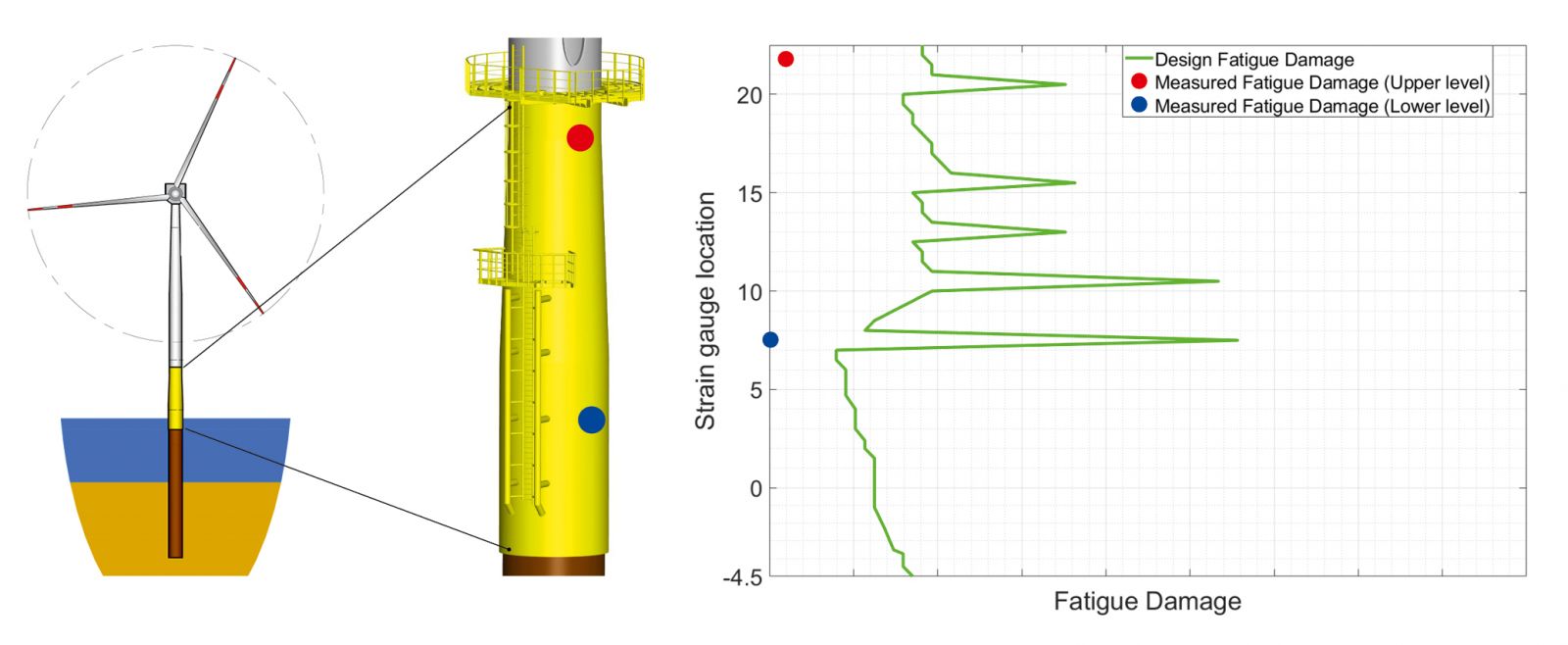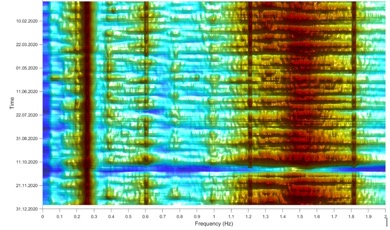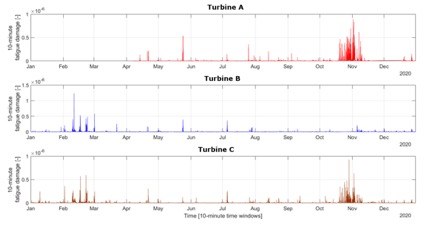Structural Health Monitoring: Quantifying material fatigue for lifetime extension
 Environmental protection alone isn't enough; power from renewable energy sources must also be competitive with its fossil-fuel-generated counterparts. Especially for offshore wind turbines, whose production represents a significant proportion of renewable energies, the costs for operation and maintenance are dominant. Data from structure monitoring contains a huge potential for optimizing turbine operations and extending service life.
Environmental protection alone isn't enough; power from renewable energy sources must also be competitive with its fossil-fuel-generated counterparts. Especially for offshore wind turbines, whose production represents a significant proportion of renewable energies, the costs for operation and maintenance are dominant. Data from structure monitoring contains a huge potential for optimizing turbine operations and extending service life.
Since the National Renewable Energy Laboratory (NREL) published it's "20% Wind Scenario" in 2008, the U.S. has had the goal of generating 20 percent of U.S. electricity from wind by the year 2030. To achieve this, the U.S. will have to almost quadruple its current level of electricity produced from wind energy. Offshore wind is absolutely vital to achieving this ambitious goal.
However, if offshore wind is to compete economically with other power generation sources, costs must be reduced -by up to 40 percent according to some studies. The systematic evaluation of data from structural health monitoring (SHM) helps to identify influencing factors.
Identifying - and avoiding - excessive loads
Wind turbines typically receive an operating license for a 20-year period, and the turbine structures are dimensioned based on this operational service life. After this period expires, turbines lose their operating license because, according to the design documents, safe operation is no longer guaranteed. If it can be successfully documented that the structure of a wind turbine has experienced less fatigue than predicted and that safe operation can still be guaranteed, the turbines can be kept in operation longer. This is why, in expert assessments regarding operational lifetime extension, data from structural health monitoring plays an important role in reducing uncertainties.
Because the evaluation of this data creates a precise image of the structure's behavior in real operation, the goal is to equip all offshore wind turbines with SHM. Changes in vibration patterns provide an indication of critical loads or structural damage that has already occurred. SHM has long been a method of assessing safe operation, and could also serve to optimize the prescribed inspection intervals for wind turbines. This alone would significantly contribute to lowering O&M costs, which account for nearly one-third of the total cost of offshore wind in the United States.
Furthermore, data from SHM is linked with other operating data from the wind turbine, such as the drive train condition monitoring system (CMS) data. This allows critical operating conditions to be identified and avoided. This integration of data can help to make better use of the permitted operating window, thus improving turbine productivity.

Figure 1: Comparison of measured fatigue damage to assumed fatigue damage in structure design
The following three examples demonstrate the possibilities for establishing this type of integrated structure monitoring:
1. Not built as planned
Due to their challenging structural design, wind turbines are often sensitive to vibrations. As a result, they are optimized regarding their structural eigenfrequency during the design process. This helps to prevent dangerous resonances in the structure that occur due to the excitation frequencies caused by the rotor speed. This is why the turbine controller is programmed in such a way that resonance-triggering rotation speeds are avoided as much as possible, or at least passed through quickly.
However, experience has shown that the eigenfrequency of installed turbines is often noticeably higher, meaning the tower is more rigid than presumed in the design process. This is often because the stability of the foundation soil could not be adequately assessed, and thus safety reserves were included in the structure design.
The eigenfrequency of the tower and foundation change due to the material aging process. If the eigenfrequency is measured shortly after commissioning and monitored at regular intervals, it is then possible to program the wind turbine controller to avoid the real resonances instead of the calculated ones, thus reducing the risk of material fatigue. This provides an opportunity for lifetime extension (LTE), or the possibility to continue operating turbines much longer than the calculated design service life, thus increasing both their total output and return on investment.

Figure 2: Frequency spectrum visualization of turbine tower from acceleration data
2. Shutdowns have different impacts
In the event of an emergency shutdown due to strong winds or maintenance, the rotor blades turn the wind turbine out of the wind (pitching). Although this helps to reduce the structure's peak load, it also causes fatigue damage to the blade and tower structure. Investigations show that shutting down a wind turbine during high wind speeds causes much higher loads than it does in moderate wind conditions. An emergency shutdown just below the threshold speed for shutdown, 30 m/s, results in 10-minute fatigue damage, which is more than 20 times higher than a shutdown under milder wind conditions. Wind farm operators can use SHM data to plan shutdowns accordingly to avoid unnecessary material stress.

Figure 3: One year 10-minute accumulated fatigue damages, turbines A, B, and C in a North Sea wind park
3. Even small collisions cause damage
Offshore wind turbines are designed for extraordinary events, such as storms, violent waves, or ship collisions. Just being hit with a small boat traveling at low speed in low wind conditions can have a significant impact on the structure. Although collisions are relatively uncommon, they cause serious material fatigue damage to the structure. SHM provides data for assessing the structural effect of collisions, and provide a basis for insurance and warranty claims.
Lifetime extension
The scenarios described here show that an SHM system can not only detect damage, it can also help identify damage caused by extreme weather or accidents, practically in real time, helping to play a vital role in the operation and maintenance of wind farms.
Moreover, it provides proof that the cumulative loads actually exerted on the structure during operation, and thus the material fatigue, are below the value described in the operating license. This allows the life - and the operating revenues - of the wind turbine to be safely extended.
 Kirsten Larson is Key Account Manager at Bachmann Monitoring GmbH, which provides hardware and software for wind and renewable energies.
Kirsten Larson is Key Account Manager at Bachmann Monitoring GmbH, which provides hardware and software for wind and renewable energies.
Bachmann Monitoring GmbH | www.bachmann.info
Author: Kirsten Larson
Volume: 2021 September/October










.jpg?r=5162)
